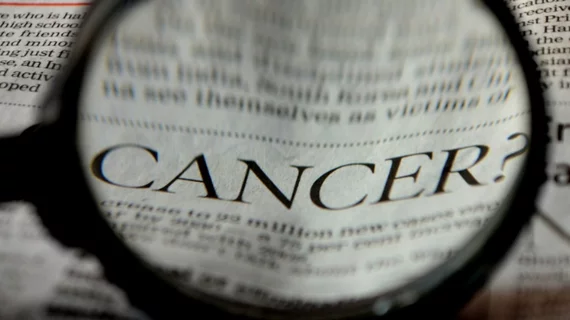5 imaging modalities have changed the war on cancer over the past 50 years. How many can you name?
Two branch chiefs with the cancer imaging program at NIH’s National Cancer Institute have produced a written commemoration to mark the golden anniversary of 1971’s National Cancer Act.
Yantian Zhang, PhD, and Robert Nordstrom, PhD, offer brief histories, status updates and future prospects of modalities that—over the five decades since President Richard Nixon signed the act into law—went from barely there to everywhere in the war on cancer.
Radiology: Imaging Cancer published the piece online this month.
“We sometimes feel as if these medical imaging capabilities have always existed and do not fully appreciate that they are relatively recent innovations,” Zhang and Nordstrom write.
However, by now the unsung technologies are ubiquitous in research as well as patient care and “will continue to help propel us toward our eventual conquest of cancer.”
Here are the modalities meriting a look back and a glance ahead in the author’s estimation.
1. Computed tomography. The 1979 Nobel Prize in Physiology or Medicine was awarded to Allan Cormack and Godfrey Hounsfield “for the development of computer assisted tomography,” Zhang and Nordstrom remind.
Leading to that milestone, they point out, the NCI and other NIH institutes supported such early advances as 1974’s “transverse section X-ray camera.” More:
CT imaging research and advances have come a long way from fuzzy images to high-resolution three-dimensional images, long acquisition times in tens of minutes per section to state-of-the-art whole-body scanning in seconds, and simple back projection reconstruction to fan-beam, cone-beam and artificial intelligence–based reconstructions. As a result of these advances, CT … is a major workhorse in today’s radiology departments and a major imaging modality used by clinical oncology.”
2. Magnetic resonance. The beginnings of MRI as a medical imaging technology trace to a 1973 publication by Paul Lauterbur, who went on to co-win the 2003 Nobel Prize in Physiology or Medicine, Zhang and Nordstrom recount.
“MRI technology rapidly developed in the 1980s, as demonstrated by the large increase in acronyms for new MRI methods,” they write. “While developing this nascent imaging modality, the academic MRI research community made great contributions to many critical research innovations.”
A search of the NCI funding record for recent MRI research demonstrates the vast clinical applications of MRI across the entire spectrum of cancer research and patient care, including early disease detection, diagnosis, prognosis, treatment and response assessment. ... [Today] MRI research projects represent a major component of the NCI’s cancer imaging program and regularly make up about one-third of the [program’s] overall grant portfolio.”
3. Positron emission tomography. Zhang and Nordstrom recognize a Washington University research team whose members led the development of PET science and instruments in the early 1970s.
In 2000, CMS began covering PET scans with the radiotracer 18 fluorodeoxyglucose (18F-FDG) to image cancer patients for diagnosis and staging. “FDG PET has since become widely used in cancer research and clinical care, driving continued advances in PET imaging technology,” the authors note.
[Hybrid] PET/CT scanners from commercial vendors became available in 2001. They have since been broadly adopted clinically. With the development of semiconductor photodetectors that can operate inside an MR magnet, the combined PET/MRI system became feasible around 2005. The imaging research community is actively pursuing PET/MRI research to fully exploit and evaluate the clinical benefits of the combined imaging modality.”
4. Optical imaging and microscopy. “With the development of laser and new light sources, new … [imaging] methods and instruments have flourished and become standard fixtures in modern biomedical research laboratories,” the authors state.
They list as examples confocal microscopy, multiphoton microscopy, optical coherence tomography, photoacoustic imaging, multiplexed fluorescence microscopy, super-resolution and light sheet microscopy. Co-developers of the field won a Nobel Prize in chemistry in 2014 for their work in “super-resolved fluorescence microscopy.”
Altogether, these new imaging capabilities are broadly adopted in clinical research and practice and have changed the landscape of discovery biomedical research.”
5. Ultrasound. Maybe the most widely adopted imaging modality in hospitals today thanks to its relatively low cost and ease of use, ultrasound has come far since the 1970s. In fact, Zhang and Nordstrom assert, in 2022 it may as well represent an altogether new imaging modality.
Among the notable advances they name are novel transducer design and higher frequency ultrasound imaging, Doppler flow imaging, use of microbubble imaging contrast agents, high-intensity focused ultrasound, and ultrasound-guided intervention.
The rich history of ultrasound technology development and expansive clinical applications in the past 50 years certainly deserve a lot more than this short paragraph; however, due to page limit of this editorial, we hope to get into this topic with more details in future communications.”
Zhang and Nordstrom close their reflection and forecast on a note of hope that history will view the 50 years following the National Cancer Act of 1971 as a period in which medical imaging “helped us open a ‘window’ through which cancer and other diseases can be investigated and better understood.”
Seeing cancer’s changes in real time, they add, from the cellular to organ and system levels—and “connecting these changes with our rapidly increased understanding of cancer at the molecular and genetic levels”—will “advance the promise of personalized and precision medicine.”
RSNA has posted the paper in full for free.

